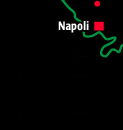|
Campania Region
“You can say or tell or paint whatever
you like but in this place everything exceeds expectations.
These shore, gulfs, inlets, Vesuvius …”. In 1787
that is what Goethe had to say about the Gulf di
Naples.
It is a fact that this region, with its towns so rich in
history and its culture dating back thousands of years, leaves
no visitor unmoved. Naples (“nea polis”: new
city), the regional capital, grew up at the foot of Vesuvius
as early as the 5th century B.C.; its old town offers one
of the most unusual and picturesque walks in the world. Particularly
at Christmastime, the famous street, known as Spaccanapoli (“splits Naples”) because it splits the city
in two, and the small adjoining ones become a medley of voices
and colours; shops decorated for the holiday season, stalls
springing up as if by magic and selling knick-knacks of every
kind; thousands of people crowd the alleys every day. The
atmosphere is at its peak in via San Gregorio Armeno, the
street of the shepherds, where skilful craftsmen, not only
at Christmas, display their art in fantastic clay statuettes:
the crib, or nativity scene, is one of the symbols of Naples
in the world, just as much as sfogliatella pastries and babas.
Every Neapolitan passes through this little street at least
once in his or her lifetime and that is why it has always
been so lively. Here, today like yesterday, are the workshops
of the artists, painters, sculptors and engravers that beautified
and embellished churches and squares. The unique atmosphere
is very well described by Eduardo De Filippo in his famous
play: Natale in casa Cupiello (Christmas at the Cupiellos).
Eduardo was a keen observer of Neapolitan society, with its
dramatic and comical sides and its characters of down-and-outs
and of heroes.
But Naples also means the beautiful sea-front of via Partenope with Castel
dell’Ovo (the castle of the egg) and the
Borgo Marinari in the foreground. Vesuvius and the island
of Capri look so near that you could almost touch them with
your hand. The same hand with which you can eat a tasty pizza,
perhaps even the simple and classic “Margherita”,
so called because it was served to Queen Margaret of Savoy
in 1889.
The fact is that in Naples the pizza is not just a convivial
pleasure, we might almost call it a sacred rite. “It
must cook faster than pasta, be neither a first course nor
a main dish, neither meat nor fish; it should be as hot as
hell and as delicious as heaven: round like the world and
burning like the summer sun”. This was the wager that
the court cook made with the king way back in the first half
of the eighteenth century.
And Naples also means the hill of Posillipo: a natural terrace
overlooking the gulf, with scenic streets where all the up-and-coming
professionals in Naples can be found every night. Naples
is the hometown of Massimo Ranieri, Nino
D’Angelo,
Mario Merola, Totò, Massimo
Troisi, and Gigi D’Alessio:
actors, singers, extraordinarily “real” poets,
with an overwhelming talent for describing human sentiments “with
their heart”.
Finally, Campania also means the Sorrento Peninsula, the
Amalfi Coast, Salerno with its beautiful Cathedral and its
Moorish bell tower, and the Royal Palace of Caserta, not
forgetting the ruins of those fantastic cities buried by
Vesuvius in 79 A.D. but more alive than ever today: Pompeii and Herculaneum.
For further information, click on:
Campania Region  ENTER ENTER
|

|



















